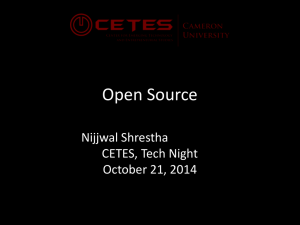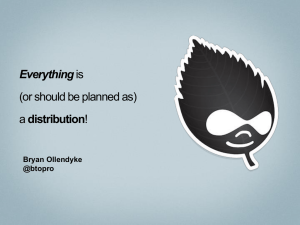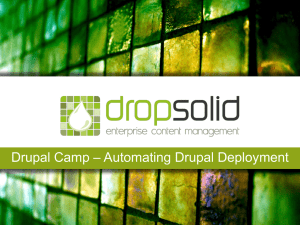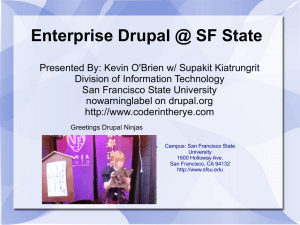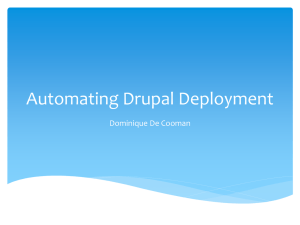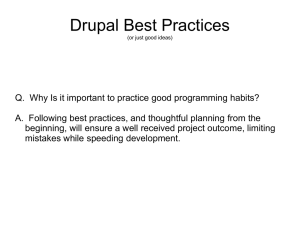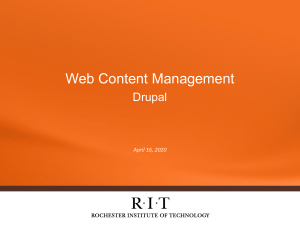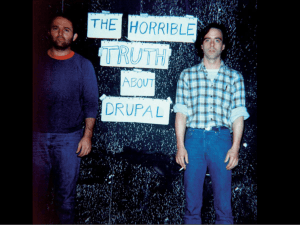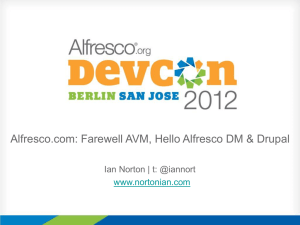Drupalatsfstate
advertisement
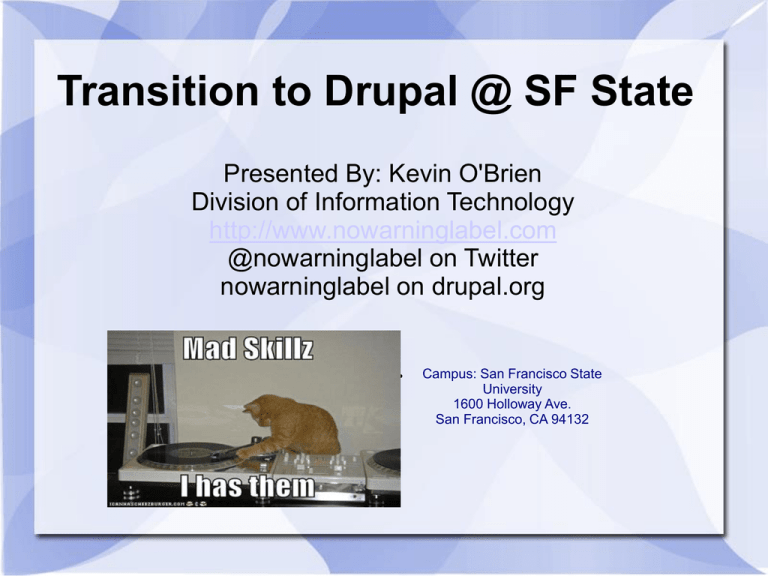
Transition to Drupal @ SF State Presented By: Kevin O'Brien Division of Information Technology http://www.nowarninglabel.com @nowarninglabel on Twitter nowarninglabel on drupal.org Campus: San Francisco State University 1600 Holloway Ave. San Francisco, CA 94132 Choosing Drupal Began with search for WCM for DoIT Tried many (Plone, OpenCMS, Joomla, etc.) Settled on Drupal for functionality and a11y 1 virtual server, no real environment Started with 4.7x quickly moved to 5.x Some other sites run on Drupal independently Ancient History Portals required on CSU campuses • • Project Approach (IBM Websphere) – Collaboration between SFSU Team and IBM Team – Approach according to the established IBM Method An emerging consensus regarding portal development includes the following major best practices and considerations: – There should be one AND ONLY ONE horizontal portal on campus; – Portals should be developed What really happened • Portal took 2.5 years to implement base features. Required constant maintenance • Other groups/depts. refused to buy-in, saw IBM WebSphere as a “black box” • Project Manager/Maintainer quit • Said hey “How about going to Drupal, they have it running successfully, maybe would take 2.5 months” on his way out the door IBM Websphere • Java Environment • JDK/JavaEE/JSR 168/WSRP • Portlet Factory • Monolithic • Broke weekly • Few expertise • No community • Only support is PMRs The A Team • Me – Architect / Developer / Designer • (~60 hours/week) • Supakit “superkid” Kiatrungrit – Developer • (~50 hours/week) • Bora Kou – Systems Admin (~25 hours/week on this proj) • Jason D'Silva – Student Asst. Developer (10 hours/week) • Management position was actually vacant Scrum style agile development • What we liked: – Quick turnaround • What we didn't like: – Scope creep – Weekly feedback – Loss of resources – Clear deadlines – – Daily checkins Cramming at end – Learning a lot – Not enough time for testing/QA – Working a lot Demo [demo] of SF State Drupal Portal [demo] of DoIT WCM Architecture • 2 Dedicated RHEL 5 boxes run Apache (Xeon 2 ghz + 4 GB RAM) • 2 Dedicated RHEL 5 boxes run MySQL (Xeon 2 ghz + 4 GB RAM) • 1 Dedicated box runs MySQL cluster mgmt node (+ MMM replication) • Load balancer in front + 2 mysql db connection scripts Big IP Load Balancer MySQL DB connection test script Apache+PHP 5.2 Apache+PHP 5.2 MySQL Cluster 7.x MySQL DB connection test script MySQL Cluster 7.x MySQL Mgmt Node Drupal & MySQL Cluster :( • • • • Drupal will not run out of the box on ndbcluster tables Problem: menu_router table and locale_sources tables Kris Buytaert presented on the topic A bug was filed with MySQL, rejected because ndbcluster doesn’t support row lengths of that size • Issues on d.o. filed to address this in core http://drupal.org/node/391130 and http://drupal.org/node/703916 • So how can we make this work? Making Drupal run on MySQL Cluster • Split the menu_router table into smaller, more manageable tables • Remove the key reference on locale_sources or change the key data type to be something other than text/blob • Provide documentation on install for the other issues • Full instructions are available here: http://www.nowarninglabel.com/home/node/42 Useful Links for MySQL Cluster • MySQL Storage Engines • MySQL Cluster • The NDB Storage Engine How to set up a load-balanced MySQL Cluster SF State Custom Modules User Interface Modules Utility Modules benefitspps deletecookies distributiongroups encryption emergencycontactpps langhide financialaidofferletter printer financialaidofferletteradmin sfsulogout militarystatus shibbolethdata namechangeselfservice validator nextmuni xmlservice officialtranscriptrequest sfsucalendar sfsulibraryhelp Getting the Community to Develop Offered two trainings – 1) How to install Drupal on your local – 2) How to create Drupal modules – 3) (Future) How to create web services Need hand-holding How to get a Module (portlet) into Portal First content should be discussed with the oversight group before beginning development to ensure Portal is the correct place for it Some departments or groups may have a page in Portal that they are responsible for and control the content for All changes must go through the development cycle Development cycle Develop code •Run unit tests •Check into SVN • Additional development •Interface testing •Tag in SVN • Verify automated tests •User acceptance testing •Content is added directly here •Management approval • Automated tests run •If any tests fail, there is no push to production • Automated tests •If any tests fail, system is rolled back to previous build • Prepare Define requirements including functionality and UI Remember you are working within the Portal template so many UI elements are predefined Define interfaces to backend systems The most common interfaces are REST/ WebServices that should follow w3 standards LDAP (V3) Determine where portlet will be located and who should have access Local development Build portlet Run unit tests Unit tests should include all UI components and all backend interfaces Check into svn Request dev build Backend Work with the data and application owners of the source systems to build the required backend interfaces Make sure you follow the defined security model if there is one, or work with us to define one if the system you are connecting to has no model defined Development (DEV) Run unit tests Run integration tests, finalize development Peer review all code Tag SVN code for test Request Test build Code is pulled from SVN into Dev Test/ Quality Assurance (TEST) Define test plan and execute all functional tests Tests must include all functions, UI components, and backend interfaces Perform user acceptance testing Perform load/performance testing Submit automated test suite for Staging and Prod This test suite must be comprehensive Make any content only changes directly in Test A manager must sign off indicating the following: He/she is aware of all changes going into production and approves them for the specified date The automated tests sufficiently cover all functionality All code has been peer reviewed The load/performance tests prove that the application meets the minimum requirements Tag code in SVN for roll out Code is automatically pulled from TEST at 1am and deployed into staging Staging Automated test suite is run If any tests fail, production roll out is not performed If all tests pass, promotion to Prod occurs automatically at 6am Production (PROD) Automated tests are run If any tests fail, production is rolled back to previous release Accessibility 508 compliant All pages were run through manual checks Theme is color contrast compliant Security IP based Access for back-end services Everything is behind a firewall Everything is behind Shibboleth auth Core PHP Module is removed Role based access to pages Daily log checks (in future, archive logs in central change mgmt repository) Grendel-Scan OWASP standards Scalability • Handled ~350 concurrent users without problem • 4,600 visitors/day • 101,000 visits and 574,926 page views Shibboleth single-sign on & Google Analy. • Servers are way underutilized, use about 15% on norm • Load balance / Auto failover (actually tested) • No outages yet over 3 mos. Performance • Initial Build took 7.5+ sec. Load times • Used Xdebug to find drupal_http_request was problem. Used cron to cache • Down to 3.5 sec load times. • Installed APC via PECL (quite easy) • (Make sure to give it enough memory) • Down to 1.5 sec load times. • Ensure Oracle db connects quit if can't reach Where we are Now vs. Where we want to be Now campus websites are fragmented, outdated Not all sites use Univ. Template, and some don't use it correctly or update it timely We have a monthly meeting Drupal User Group Depts. want to put sites in centrally managed highly available Drupal install for easily keeping sites up to date 1 Drupal theme means a consistently updated look Need installation profile for point & click Drupal is not the solution for everything (though I love it) Drupal is not – our document management system (though it could be someday) We use Sharepoint – our project management system (again Sharepoint) – our help desk ticketing system (remedy) It can be made to do all these things, but other products are out there The Importance of Community Drupal.org Bay Area / Berkeley / South Bay DUGs IRC: #drupal-support or #drupal On campus: http://drupal.sfsu.edu/drupal Monthly Drupal meetups California Higher Education Group: http://groups.drupal.org/california-highered Questions? Contact: kobrien@sfsu.edu @nowarninglabel on twitter http://www.nowarninglabel.com
